

First series - See The Hornet issue 173 (31st December, 1966) to issue 184 (18th March 1967).
Second series - See The Hornet issue 245 (18th May, 1968) to issue 253 (13th July, 1968).
Writer:- The Hornet editorial team? Artists:- First series - Not Known; Second series - Keith Shone.
Main cast:- Pilot Officer, (later Flight Lieutenant, then Squadron Leader) Richard Starr, Pilot Officer (later Flight Lieutenant Jimmy/Johnny Penrose (first & second series), Sergeant Fred Ludd (first series), Pilot Officer Don Kendal (first series), Pilot Officer Parry (first series), Flight Lieutenant Foster (first series), Pilot Officer Tim Vale (first series), Flight Lieutenant Hamilton (second series), Flight Lieutenant MacDonald (second series), Flying Officer Lee (second series), Wing Commander Perrot (second series), Air Vice-Marshall Bostock (second series).
Time period:- Valenciennes, France and Hangmere Airfield, England, Summer 1940, (first series) and Woodford Airfield, England, Autumn 1940, (second series) during the Second World War (1939 to 1945), mid-20th Century.
(The title of this series and the hero's name led me to believe at first that this series was set in outer space!)
It's probably true to say that most armed forces finest hours are earned through being in combat. One of the Royal Air Force's (RAF), finest hours (if not their finest so far), was The Battle of Britain. When the heavily outnumbered pilots of RAF Fighter Command fought the German Air Force (Luftwaffe) for the command of the skies, above Britain. RAF Pilots from Britain and former British Empire countries for example, Australia, Canada, New Zealand, South Africa and others fought along side other nationalities including Poles, Czechs, French, a handful of American volunteers and so on against the Luftwaffe bombers and fighters. Had the RAF lost, Great Britain could have been invaded by the Germans. This series takes place during that decisive summer and autumn of 1940.
This is a no nonsense, tough series, with no room for humour. Starr at the beginning of this series is a fighter pilot with 777 Squadron in France waiting for the Germans to end the phoney war. Starr is dedicated to being as prepared as possible in the art of being a fighter pilot. So we see Starr ensuring that his Spitfire's guns are calibrated correctly and that he can hit clay pigeons whilst he himself is moving from the back seat of a tandem bicycle. (This last idea sounds a bit far fetched, but I wouldn't be surprised to learn that pilots did something similar). In issue 174, he even spends a night in full flying kit under his Spitfire in the event of a scramble, in case the Germans attack in force. (Note the word 'scramble' is an RAF slang term meaning to move fast and get your aeroplane in the air as fast as possible).
Starr kept a record of useful information in a book he calls his diary. Information in the diary included sketches of different types of planes, World War One ace's individual battle tactics, notes on air gunnery and so on. He was also keen to pass on this information to others. And if he feels he is correct in having said something, he will stick to his point of view, no matter what.
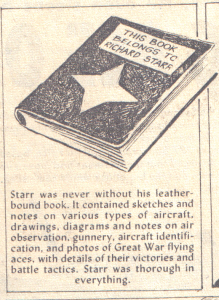 |
 |
The point of all this training and dedication? Starr's aim was to shoot down as many enemy aircraft of the German Air Force, the Luftwaffe, as possible. But its not just the plane that Starr's after, he wants to kill the pilot. Starr 'always tried to get the pilot. Cripple an aircraft and the pilot might escape. Finish the pilot and the aircraft was finished too. It was ruthless, but it was the only way to fight a ruthless enemy like the Germans.' (The Hornet, Issue 176, page 30, panel 7). [Some pilots may well have fought the battle in this manner]. He even shoots and kills a German pilot who has parachuted from a burning plane. However, Starr did this as an act of mercy, as the pilot was being burnt alive due to the oil and petrol on his uniform. This may seem a cold-hearted attitude, but this series was set during the period before, during and after The Battle of Britain. A time when Great Britain had its back to the wall and in order to survive had to rely on the fighter pilots do whatever was necessary to ensure that the country survived the Luftwaffe onslaught and continue the struggle against a battle hardened opponent, Nazi Germany.
The pages below are examples of what Starr may well have had in his diary and are from the book Britain's Wonderful Air Force, edited by Air Commodore P.F.M. Fellowes, D.S.O. London, Oldhams Press Ltd. 194?
This book was written during the Second World War, after The Battle of Britain, to give the public an idea of how the R.A.F. operated, but without giving away any secrets that the Germans weren't aware of. Chapters include - the organisation of the service, training of pilots, various types of aircraft, the role of the various commands, Fighter, Bomber, Coastal and Army Co-Operation Commands, aerial strategy and tactics, the role of the ground crews, the role of the air/sea rescue ships and so on.
[Interestingly, the picture of Starr brushing up on his gunnery above is an exact copy of the 'aiming at the enemy' image below. Maybe this book was used as a reference work for the series].
 |
 |
 |
 |

It's not long though before the Luftwaffe attack in earnest and 777 Squadron are in the thick of the fighting and being driven back towards the English Channel. After one sortie Starr has to make a pancake landing (that is landing without an undercarriage), in a badly shot up Spitfire at his aerodrome which is under attack from enemy ground forces. The plane may never fly again, but it's guns will still fire and Starr is able to use them against the attacking enemy armoured vehicles. Later, the remaining pilots and ground crew leave the airfield in a small passenger Anson plane. (A Pay Accounts Officer attempts to board the plane on the grounds he is an important officer. Starr is unimpressed and denies him a seat and is even prepared to shoot the officer in order to keep him off the plane). Starr is able to fly the plane back to England and land it, even though he is wounded during the flight.
With the Battle of Britain in full swing new pilots join 777 Squadron, among them a cocky Pilot Officer Penrose who soon gets right up Starr's nose with his 'I know it all attitude,' doing victory rolls over the airfield and being the media's darling. (If there's one thing that makes a senior officer's blood boil, it's pilots doing a victory roll over their airfield)! Penrose is though a good pilot and has eleven confirmed kills to his name. Penrose's fame reaches the ears of a German fighter ace Franz Hausen, The Leopard. Penrose is so eager to duel with The Leopard, that he disobeys orders during a sortie and chases after fighters, in the hope one of them is Hausen instead of the bombers.
This has serious consequences for Sergeant Ludd, Starr's wingman, who had just landed at Hangmere Airfield due to combat damage. A bomber reaches the aerodrome and drops its bombload killing Ludd. Starr is furious with Penrose who realises his mistake. If he had engaged the bombers instead of the fighters as ordered, Ludd might still be alive. Starr though allows Penrose another chance and he becomes Starr's wingman. (The Ace of Space shoots down The Leopard). By the end of the first series, 777 Squadron has been pulled out of the front line and rested. Starr becomes a training instructor before being promoted to Squadron Leader.
The story below is an episode from the first series, issue 182. The squadron are in the thick of the battle and are beginning to take casualities and the strain of flying and fighting is starting to take it toll on the pilots.
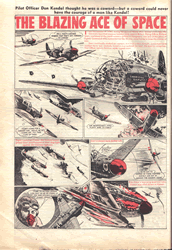 |
 |
 |
Second Series.
987 Squadron based at Woodford Airfield are the worst fighter unit in the RAF. The squadron had been badly mauled in The Battle of Britain, as they had been flying the slow and difficult to manoeuvre Defiant aircraft. A plane with a rear turret. As a result the squadron had been pulled out of the action and morale had dropped. The ground crew are sloppy and slow and the pilots aren't much better. But that's about to change, when Squadron Leader Starr flies in!
There then follows an intense period of training, with Starr pushing the squadron to fly better in formation, improve their shooting and general flying skills. Starr is in danger though of losing the Spitfires that his squadron is equipped with as a senior officer feels they would be of better use elsewhere. Starr disagrees and with Hamilton and his wingman Lee puts on a superb exhibition of flying. The squadron keep their Spitfires and become a fully operational unit again.
Throughout the second series, Starr is plagued by Wing Commander Perrot, who regards Starr as a trouble maker. For example, the Squadron Leader criticises the 'Rhurbarb' flying missions. (A 'Rhurbarb' consists of groups of planes heading into enemy occupied Europe and causing as much damage as possible against any target of opportunity that presented itself. This tactic was adopted by the R.A.F. and was heavily critised by the pilots. These missions were carried out even when the weather was bad). Perrot sees his chance and reports Starr, in the hope he will be relieved of his command. Starr avoids this by carrying out a 'Rhurbarb', but on his terms. That is, he finds a suitable target thanks to his diary. (The diary only makes brief apperances in this series).
One episode sees Penrose now a Flight Lieutenant joining Starr at 987 Squadron. But is he fit to fly? Read the story below. (For some reason Penrose's first name in this series has been changed to Johnny). Other exciting stories for Starr followed. In issue 251, Starr shoots down a German Red Cross plane, but only after he's noticed that it is well inland over England and flying a definite search pattern which leads Starr to think it is on a photo-reconnaissance mission. And therefore a legitimate target to be shot down. This leads Starr to be relieved of his command by Wing Commander Perrot and sent on leave. Starr though, has other ideas and hitches a ride with a Blenheim squadron, flying as an air gunner. But its not long before he is flying a crippled Blenheim back to England. Further good news awaits Starr on his return. The 'Air Ambulance' was not equipped to carry wounded and he is re-instated as Squadron Leader of 987 Squadron.
Starr's final storyline involves him ramming an enemy fighter which is attempting to shoot a bailed out bomber crew in the sea, with his plane. (Starr had run out of ammunition). Starr survives the collision and makes for a German rescue craft. (Both sides provided unmanned rescue crafts in the English Channel, especially for shot down crews to use. The craft provided shelter from the elements, food and warmth until they could be rescued. See the image below).
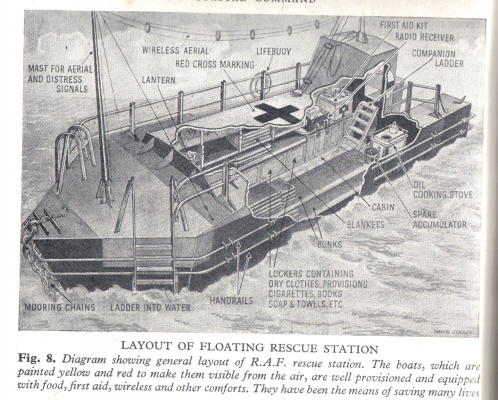
This series isn't just the story of Richard Starr, but also of other pilots such as Penrose. The reader also learns a lot about the tactics that were used by the British, a very brief history of the battle itself, the different attitudes of new and experienced pilots and the stresses that took their toll on the pilots. The artwork in both series is excellent. The writing has the feel of someone who has either read a lot about The Battle of Britain or possibly was ex-R.A.F. Either way, this series is an exciting, informative and riveting read.
The story below is taken from the second series and sees Jimmy/Johnny Penrose rejoin Starr at 987 Squadron. (Issue 249).
 |
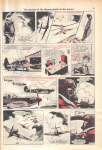 |
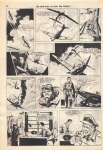 |
 |
For those who are interested in learning more about the history of these events please visit the R.A.F.'s timeline pages. for further information.
 |
 |